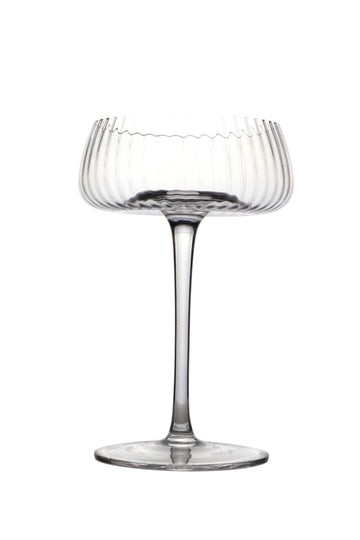The classic flute is of significant height and small in width and is equipped with thin stem, which prevents the hands from reaching to cold wine. Its tiny surface area reigns in carbon dioxide evaporation, enforcing exuberant effervescence throughout from pour one to the last. The rim being tight, citrus, green apple, and brioche notes head straight to the nose so that aromas remain fresh and intense. For more formal receptions, wedding toasts, and fast occasions of celebration the flute is still the choice by default, since it defines brisk bubbles and brings tidy, sharp fragrances.
Appreciating the Tulip Champagne Glass
The tulip glass has a narrow base, which curves outwards and then gently curves inward toward the rim. This larger belly leaves vintage cuvée’s just a little of room to breathe, opening them just enough to let the tiniest suggestions of hazelnut, honey and white blossom play. At the same time, the curve in that is close to the lip maintains a constant bead of bubbles and precludes a spillover of foam. Professionals of wine often advise the use of tulips for aged prestige champagnes since it manages to get the balance between the best expression of aroma and the elegant bubbliness.
Embracing the Vintage Coupe
The coupe has a broad shallow bowl that brings to the viewer’s mind the pictures of roaring‑twenties parties, Art Deco glamour. Its open design lets bubbles escape more easily than in a flute, but carries out a smooth, wide swan of wine over the palate that can make demi‑sec and rosé styles luxurious and silky. The large surface area begs for garnishes, such as fresh berries, or edible flowers and dramatic tower stacks are possible. When atmospherics and visual panache trump continued effervescence, the coupe irresistibly exudes charisma.
Exploring Stemless Champagne Glasses
Stemless champagne glasses exchange the stem for a sturdy base, which shifts the center of gravity and minimizes the possibility to tilt. Their bowls tend to reflect either flute or tulip profile; thus, the bubble behavior retains dignity, but direct hand contact can speed warming up of wine better. A large number of modern designs employ double‑walled construction in order to minimize heat transfer and condensation occurrence. Lightweight and robust, stemless options are great to match outdoor brunches, rooftop parties, and more informal gatherings where ease of handling is of the essence, along with style.
Considering Specialty Shapes
Other than the standard forms of the flute, tulip, coupe, and the stemless, the glassmakers create speciality champagne glasses to enhance certain characteristics. Trumpet flutes are taller than regular flutes, spraying streams of bubbles in long and dramatic columns that reflect light in epic ballrooms. Hybrid white-wine stems, a little larger than flutes, express the minerality to grower champagnes expressing terroir. Some producers work with artisans on proprietary shapes, tweaking curves and rim diameters to flatter flagship cuvées. These niche designs show how small alterations in geometry can finetune out aroma release, mouthfeel and presentation.
Choosing Between Crystal and Glass
Material affects appearance and appeals of champagne service. Lead‑free crystal provides brilliant refraction and virtually weightless walls against the lips, increasing the feelings of finesse. Top‑quality tempered glass is stronger and cheaper, but transparant and bright. Either one of them will offer seamless joins between the bowl, stem and foot for durability and clean silhouette. The same thickness ensures that there is an even temperature throughout and fewer stress points that would crack when subjected to normal handling.
Caring for Champagne Glasses
Clean glassware is not only pleasing, but also makes glassware last longer. Rinse each glass shortly after use using warm water and a mild, odorless detergent to dispel residue that eats away clarity. Rinse thoroughly to remove soap, then use lint free cloth to dry the glass while upside down to prevent water spots. Store upright with space between units so that bowls will not touch, keeping off delicate rims from chipping. A brisk polish of each glass with a microfiber towel before the next pour reinstates brilliance and has each strand of bubbles rise through perfectly transparent glass.
Take Every Celebration to the Next Level with the Right Champagne Glass
Choosing the best champagne glass can transform an ordinary sip into a magical sip. A flute protects powerful bubbles for sharp non vintage combinations, tulip releases layered aromas from aged prestige bottles, coupe completes silky texture and vintage luxury, and a stemless shape provides contemporary functionality without loss of fizz. Pairing glass to the style & mood of the wine lets citrus shine, brioche calm and berry note flower just as the winemaker wanted. Keep a tasteful combination of these forms and every occasion, from casual brunches to milestone anniversaries, will be more elegant, more flavored, and more memorable with every clink.







